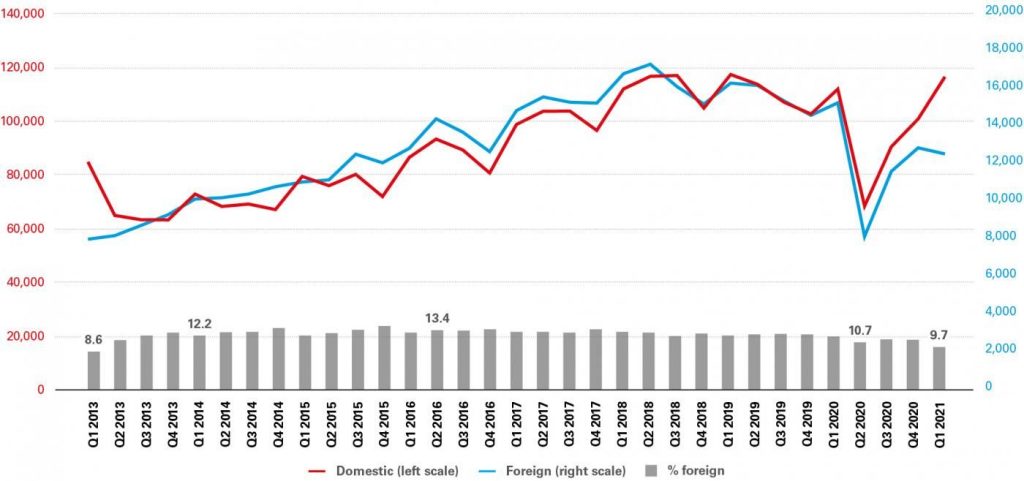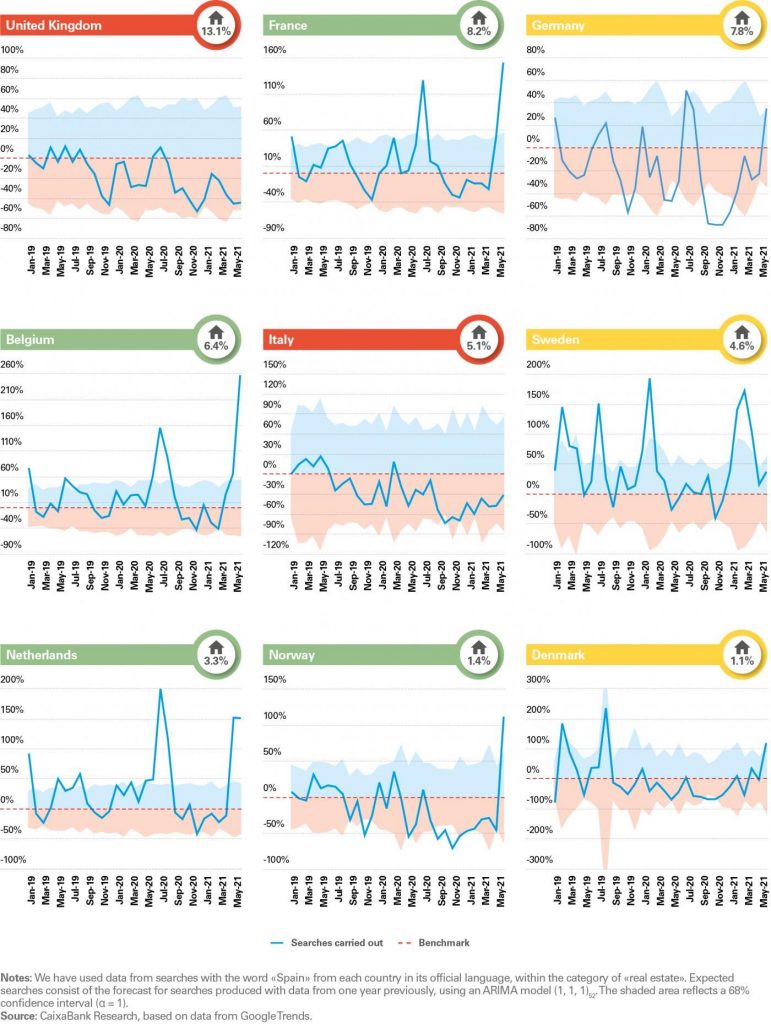Judit Montoriol-Garriga (CaixaBank Research)| There is no doubt that the pandemic severely affected the property market on the Mediterranean coast and islands throughout 2020 and the first few months of 2021. The slump in international tourism due to restrictions on travel and uncertainty regarding how the health and economic situation would develop have led to a significant decline in the number of foreigners buying residential properties in Spain, plummeting by almost 50% year-on-year in Q2 2020. Although purchases began to recover in the second half of last year, they could not avoid ending the year with a sharp fall of 24.2%, almost 10 pp more than the decline recorded in purchases by Spaniards (–15.6%), which were not so severely affected by restrictions on travel within the country.
The restrictions on international travel in place in Q1 2021 continued to weigh heavily on foreign demand, which still posted significant declines in year-on-year terms (–17.8%) while domestic purchases were starting to recover slightly (4.1% year-on-year, –0.7% with respect to Q1 2019). As a result, the share of foreign purchases out of all sales fell below 10% in Q1 2021 (to 9.7%), something not seen since 2013.
Nevertheless, in spite of this slump in foreign demand, the numbers of transactions have remained strong: foreigners bought around 47,500 homes in Spain in 2020 (11.3% of all sales), a figure similar to that of 2015 and much higher than the average for 2008-2014 (28,000 homes per year), suggesting their interest in acquiring a residence in our country has not diminished.
One factor that has helped to sustain international purchases during the pandemic has been the digitisation of the marketing and financing for new developments. Developers that had already invested in adopting new digital technologies have been able to continue offering their services remotely, for example through virtual tours of properties. Financial institutions have also improved the range of digital products and services for their non-resident customers, offering the possibility of opening an account or applying for a mortgage 100% online, among other facilities.

Uneven impact depending on the buyer’s nationality
The overall trend in purchases by foreigners is a sharp fall in 2020 and a certain recovery in 2021, but both the size of the decline and the speed of the recovery are quite different depending on the buyer’s country of origin.
Among the major markets for Spain, British purchases fell the most sharply in 2020 (–29.1%), not only because of the strong impact of the pandemic in the UK but possibly also because of Brexit. Nevertheless, this was still the nationality that bought the most homes in Spain in 2020 (around 6,200, 13% of all foreign purchases) and purchases are recovering at a similar speed to the other two major buyers, the French and Germans, a recovery which is relatively slow (the chart shows the German bubble below the 45-degree straight line marked in red dots). The Netherlands is in a similar position, with its purchases falling slightly but a slower recovery.
On the other hand, Norway, China and Ukraine recorded the largest declines in 2020 and showed no signs of recovery in Q1 2021. However, this is not a worrying statistic as the relative weight of these three nationalities combined only accounts for 6.3% of the total, as indicated by the size of the bubble in the chart. Finally, Morocco, Belgium and Sweden show a positive trend, posting a limited decline in 2020 and a rapid recovery in Q1 2021. In particular, Morocco stands out as the only nationality with a year-on-year growth (9.2%) in purchases in Q1 2021.

Waiting for foreign demand
Looking to the future, the prospects for recovery are encouraging, as suggested by the number of Google searches on buying a home in Spain carried out from other countries. In May, coinciding with the start of the easing of restrictions on international travel, there was a strong recovery in the intention to buy on the part of foreigners, especially in France, Belgium, the Netherlands and Norway. In contrast, searches from the UK and Italy remain depressed, with Germany, Sweden and Denmark somewhere in the middle. It is expected that the progress of the vaccination campaign in European countries and the implementation of the EU’s COVID digital certificate will boost the pent-up demand from foreigners, who are waiting until they can travel to buy a home in Spain.15 In addition, new work patterns accelerated by the pandemic, such as teleworking, will allow European workers to stay in Spain for longer periods of time to enjoy the Mediterranean climate while working remotely, so the market now has a new profile of international buyer.







